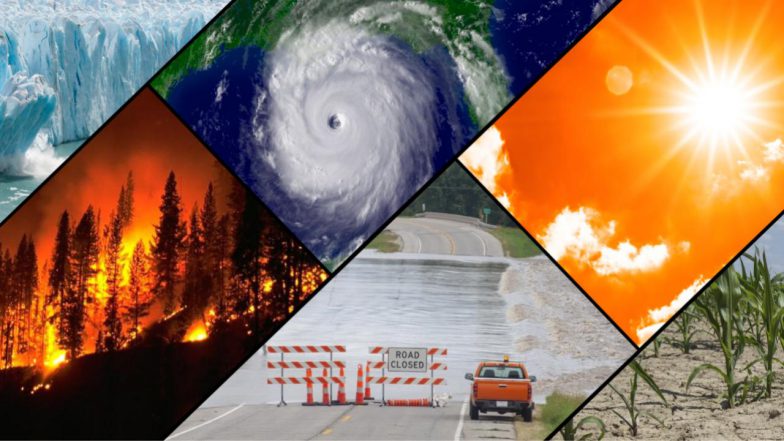Summary
Climate change adaptation refers to adjusting to the effects of climate change, like extreme weather events and rising sea levels. It involves reducing vulnerability and minimizing potential harm, while also capitalizing on new opportunities. Adaptation strategies can be implemented across sectors such as infrastructure, agriculture, and public health, and can involve both human and natural systems.
Source: Other
British International Investment – 12/06/2025 (04:18)
A brief understanding of what causes Climate Change, what it could mean, and why it’s urgent that we do something about it.
OnAir Post: Climate Change Adaptation
News
For the first time, social media overtakes TV as Americans’ top news source
There’s always been a lot of hand wringing over how the “mainstream media” covers particular issues, especially political ones, but we’re at a point where the term “mainstream media” is pretty much an anachronism. Independent media wields significant influence now, and we have the collective ability to drive attention and interest toward issues regardless of how they’re covered by the legacy media. That’s not to say that traditional media doesn’t continue to play an important role in our information ecosystem, but it’s no longer the gatekeeper it once was. [Nieman Lab]
$250K from LinkedIn in one year
Platforms like Threads and Bluesky are often cited as the main Twitter competitors, but LinkedIn was probably the greatest beneficiary of the post-Elon Twitter exodus, especially since it absorbed a lot of the business influencers who used to publish long viral tweet threads. I think one of LinkedIn’s biggest assets is that it doesn’t have restrictive character limits, and instead simply hides longer posts behind a “read more” button. This allowed people to start using it as something closer to a real blogging platform — a more scalable Medium, at least when it comes to business content. [Creator Spotlight]
About
Source: Gemini AI Overview
Key aspects of climate change adaptation
- Minimizing Harm
Adaptation aims to reduce the negative impacts of climate change, such as damage from extreme weather, food and water shortages, and displacement due to rising sea levels.
- Exploiting OpportunitiesClimate change can also create new possibilities, such as the expansion of agriculture into new regions or the development of new industries related to renewable energy.
- Variety of ApproachesAdaptation strategies can be diverse, including infrastructure improvements (e.g., building seawalls), technological advancements (e.g., developing drought-resistant crops), behavioral changes (e.g., water conservation), and ecosystem-based solutions (e.g., restoring wetlands).
- Proactive and ReactiveAdaptation can be either proactive, anticipating future impacts and taking steps to prepare, or reactive, responding to events as they occur.
- Global and LocalClimate change impacts vary by region, requiring both global cooperation and locally tailored solutions.
Examples of Climate Change Adaptation
- InfrastructureBuilding seawalls, upgrading drainage systems, and relocating vulnerable infrastructure to higher ground.
- AgricultureDeveloping drought-resistant crops, improving irrigation systems, and diversifying crop types.
- Water ManagementImplementing water conservation measures, developing new water storage facilities, and managing water resources more efficiently.
- Public HealthStrengthening public health systems to respond to heat waves, infectious diseases, and other climate-related health risks.
- EcosystemsRestoring and protecting natural habitats like wetlands and forests, which can help mitigate the impacts of extreme weather and sea-level rise.
Challenge
Climate change adaptation faces several key challenges, including inadequate resources, knowledge gaps, institutional limitations, and the need for better coordination across sectors and levels of government. Additionally, the urgency of the situation, especially for those in vulnerable regions, and the complexity of executing large-scale adaptation measures, like infrastructure changes or shifts in agricultural practices, pose significant hurdles.
Initial Source for content: Gemini AI Overview 7/15/25
[Enter your questions, feedback & content (e.g. blog posts, Google Slide or Word docs, YouTube videos) on the key issues and challenges related to this post in the “Comment” section below. Post curators will review your comments & content and decide where and how to include it in this section.]
1. Funding and Resources
- Inadequate FinanceMany developing countries, many of which are uniquely vulnerable to climate change impacts, lack the financial resources to implement necessary adaptation measures.
- Resource AllocationEffectively distributing adaptation funding, particularly to vulnerable communities and subnational levels, is crucial but often challenging.
2. Knowledge and Capacity
- Knowledge GapsThere’s a need for more research and information on the specific impacts of climate change in different regions and how best to adapt to its effects.
- Capacity BuildingSubnational actors, including local governments and communities, often lack the specialized knowledge and skills needed to develop and implement effective adaptation strategies.
- Behavioral ResistanceChanging behaviors and practices, like adopting new farming techniques or building codes, can be difficult and require addressing resistance.
3. Governance and Coordination
- Multilevel CoordinationClimate change adaptation requires coordination across all levels of government (national, regional, local) and between all sectors (e.g., agriculture, water, health).
- Institutional CapacityStrengthening the capacity of institutions at all levels to plan, implement, and monitor adaptation actions is essential.
- Integrating Indigenous KnowledgeIncorporating local and indigenous knowledge systems into adaptation planning can improve effectiveness and ensure culturally appropriate solutions.
4. Prioritizing Vulnerable Populations
- Equity and JusticeEnsuring that adaptation efforts prioritize the needs of the most vulnerable populations, including the poor and marginalized, is crucial to avoid exacerbating existing inequalities.
- Addressing Systemic InequalitiesClimate change impacts often disproportionately affect communities already facing systemic disadvantages, highlighting the need for adaptation strategies that address these underlying vulnerabilities.
5. Addressing Complex Systems
- Infrastructure DevelopmentAdapting infrastructure like roads, buildings, and water systems to withstand more extreme weather events requires robust planning and investment.
- Shifting Agricultural PracticesAdapting agricultural practices to changing climate conditions, such as increased drought or altered rainfall patterns, is a challenge that requires research, extension services, and farmer education.
- Managing DisplacementClimate-related displacement, whether from sea-level rise or extreme weather events, requires careful planning for relocation, resettlement, and social support.
Innovations
Climate change adaptation research and innovation are crucial for solving the impacts of a changing climate. Top areas include utilizing technologies like AI, Earth observation, and IoT for monitoring and decision-making, developing nature-based solutions, and improving climate-resilient infrastructure. Furthermore, research into economic and social systems is vital for facilitating the necessary transformations.
Initial Source for content: Gemini AI Overview 7/8/25
[Enter your questions, feedback & content (e.g. blog posts, Google Slide or Word docs, YouTube videos) on innovative research related to this post in the “Comment” section below. Post curators will review your comments & content and decide where and how to include it in this section.]
1. Technological Innovations
- Artificial Intelligence (AI)AI is being used for everything from predicting extreme weather events to optimizing resource management in agriculture.
- Earth Observation (EO)Satellites and other EO technologies provide crucial data on climate change impacts, including sea-level rise, glacier melt, and deforestation.
- Internet of Things (IoT)IoT devices can monitor environmental conditions in real-time, enabling more effective responses to changing situations.
- Advanced ComputingHigh-performance computing is essential for running complex climate models and simulations that inform adaptation strategies.
- DronesDrones are used for various tasks, such as monitoring infrastructure, surveying damaged areas after extreme weather events, and delivering aid.
- Virtual and Augmented Reality (VR/AR)VR/AR can be used to visualize potential climate impacts, educate the public, and train emergency responders.
2. Nature-Based Solutions
- Ecosystem RestorationProtecting and restoring mangroves, wetlands, and forests can provide natural defenses against sea-level rise, floods, and droughts.
- Sustainable AgricultureDeveloping drought-resistant crops, implementing water-efficient irrigation systems, and promoting soil health can enhance food security in a changing climate.
- Urban GreeningIncorporating green spaces, such as parks and green roofs, can help mitigate urban heat island effects and improve air quality.
3. Infrastructure and Planning
- Resilient InfrastructureDesigning and upgrading infrastructure, such as roads, bridges, and buildings, to withstand extreme weather events is essential.
- Early Warning SystemsDeveloping and improving early warning systems for extreme weather events can help communities prepare and evacuate, minimizing loss of life and property.
- Water ManagementImplementing water conservation measures and developing efficient irrigation systems can help address water scarcity issues.
- National Adaptation Plans (NAPs)NAPs provide a framework for integrating climate change adaptation into national policies and strategies.
4. Social and Economic Systems
- Economic DiversificationReducing reliance on climate-sensitive sectors and promoting economic diversification can help communities become more resilient to climate change.
- Insurance and Financial MechanismsDeveloping innovative insurance products and financial mechanisms can help communities cope with climate-related losses.
- Community EngagementInvolving local communities in adaptation planning and implementation is crucial for ensuring that solutions are tailored to specific needs and contexts.
- Policy and GovernanceImplementing policies that incentivize climate-friendly practices and discourage harmful activities is essential for driving large-scale change.
Projects
Climate change adaptation projects focus on reducing vulnerability and building resilience to the impacts of a changing climate. Current and future projects include developing drought-resistant crops, improving water management, building flood defenses, and transitioning to renewable energy sources. These initiatives are crucial for protecting communities, infrastructure, and ecosystems from the effects of climate change.
Initial Source for content: Gemini AI Overview 7/15/25
[Enter your questions, feedback & content (e.g. blog posts, Google Slide or Word docs, YouTube videos) on current and future projects implementing solutions to this post challenges in the “Comment” section below. Post curators will review your comments & content and decide where and how to include it in this section.]
Current and Future Projects Focused on Climate Change Adaptation
- Sustainable AgricultureDeveloping drought-resistant crops and implementing regenerative agriculture practices to improve soil health and water retention. This includes practices like no-till farming and cover cropping, which can help mitigate the impacts of drought and improve the resilience of agricultural systems.
- Water ManagementImproving water storage and distribution systems, promoting efficient irrigation techniques, and managing water resources more sustainably to adapt to changing rainfall patterns and increased water scarcity.
- Infrastructure DevelopmentBuilding seawalls and other coastal defenses to protect against rising sea levels and storm surges. This also includes retrofitting buildings to improve energy efficiency and resilience to extreme weather events.
- Nature-Based SolutionsImplementing green infrastructure, such as green roofs and urban forests, to reduce the urban heat island effect and manage stormwater runoff. Restoring wetlands and mangroves to protect coastlines and provide natural flood defenses.
- Renewable Energy TransitionExpanding the use of solar, wind, hydro, and geothermal energy to reduce reliance on fossil fuels and lower carbon emissions.
- Early Warning SystemsDeveloping and improving early warning systems for extreme weather events, such as floods, heat waves, and droughts, to enable timely responses and minimize loss of life and property.
- Community-Based AdaptationEmpowering local communities to develop and implement adaptation strategies tailored to their specific needs and vulnerabilities. This includes providing access to resources, training, and information to support local adaptation efforts.
- Climate-Resilient InfrastructureIntegrating climate considerations into the design and construction of new infrastructure projects, ensuring that they can withstand the impacts of climate change.
- Financial MechanismsDeveloping innovative financial instruments, such as climate-resilient bonds and insurance products, to support adaptation investments and manage climate-related risks.
- Climate-Smart Urban PlanningIntegrating climate considerations into urban planning and development to create more sustainable and resilient cities.
Specific Examples
- The Global Adaptation Network (GAN)A network of organizations and individuals working to accelerate the implementation of adaptation solutions worldwide, according to the United Nations.
- The UNDP Climate PromiseA program that supports developing countries in enhancing their Nationally Determined Contributions (NDCs) to the Paris Agreement, including adaptation actions, according to the UNDP Climate Promise.
- The Green Climate Fund (GCF)A global fund that provides financial resources to developing countries to support climate action, including adaptation initiatives.
- The Africa Minigrids ProgramA program that supports the deployment of solar minigrids in rural communities to provide access to reliable and affordable energy.


